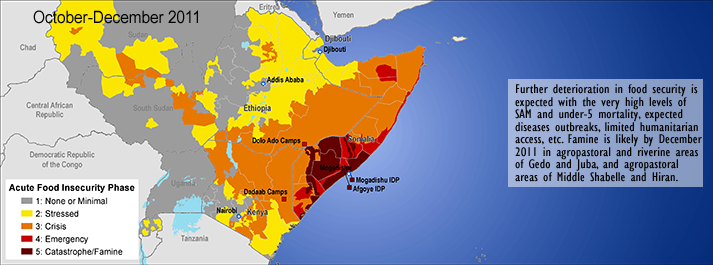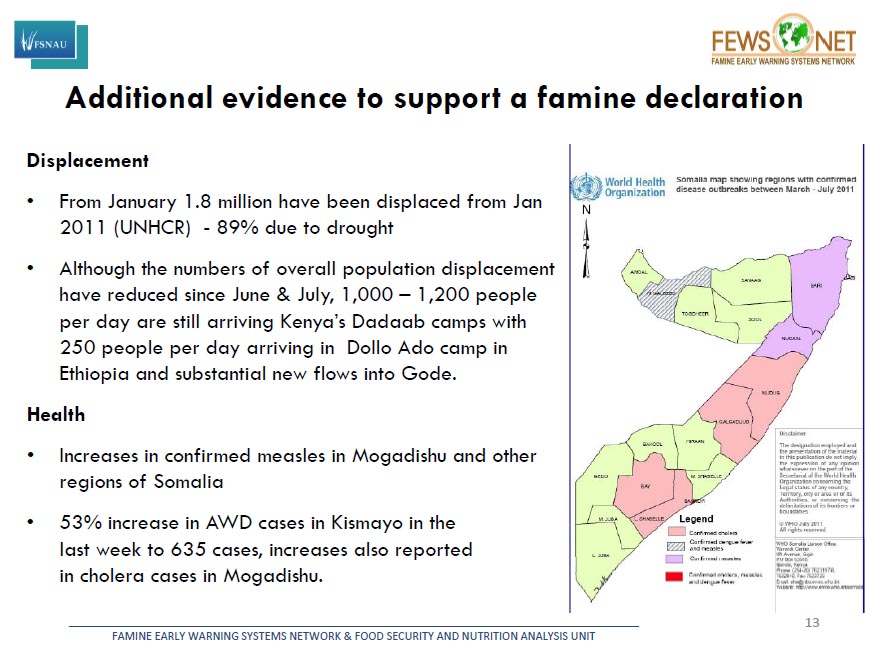The following , titled “Famine Officially Declared in Somalia,” was written by Libby White, a Computer Resource Specialist who works with the Geography’s Climate Hazards Group and the Earth Research Institute:
On July 20th, 2011, the United Nations officially declared that Southern Somalia was suffering from famine. In order to declare a famine, at least 20% of the population must be consuming less than 2100 kilocalories a day, 30% of children must be suffering from acute malnutrition and two out of every 10,000 people must be dying of hunger each day. According to the FEWS NET (an element of USAID), Mogadishu IDPs (Internally Displaced Persons) alone reached death rates of 4.37/10,000 per day. The mortality rate for children under five is as high as 15/10,000 per day. The revised beneficiaries figures for the Nutrition Cluster are 310,000 malnourished children under 5 years of age and 75,000 malnourished pregnant and lactating women.
Famine is currently ongoing in five areas of southern Somalia: the Bakool and Middle Shabelle (Balcad and Candale) agropastoral livelihood zones, all areas of Lower Shabelle and the IDP settlements in the Afgoye corridor and Mogadishu. Due to the current inadequate humanitarian response, famine is expected to spread across all regions of the south in the coming 4 to 6 weeks. In the north, a humanitarian emergency persists in Sool plateau, and assessment findings confirm that in the Hawd, Nugal Valley, Golis/Guban, and Gabi livelihood zones, the food security situation is deteriorating.
A wide range of crop failures due to dryness in the Northwest, pestilence in the central areas and late crops due to late rains in the south have all contributed to current famine conditions. A low birth rate and high mortality rate among livestock has also been a factor. Imports of rice, wheat flour, and pasta in the first half of 2011 were 98% higher than during the same period last year. At Mogadishu’s El Ma’an market, rice imports in June 2011 were 393% above the five-year average. Wages paid in food and goat-to-cereal trade have also significantly declined compared to a year ago, making access to food even more difficult.
Based on an analysis of satellite-derived Normalized Difference Vegetation Index (NDVI) imagery, current pasture conditions are below average across southern Somalia and have declined rapidly since May. Current data suggests that even with normal rains in the latter part of this year, morbidity and mortality risks will continue to increase. Additionally, due to displacement and asset losses, many pastoral/cropping households will be unable to take full advantage of these rains. As displacements continue, cultivated areas are shrinking with subsequent impacts on crop production. Migrations, insecurity and an unsure governmental authority continue to compound the Somali’s suffering.
All this comes in the midst of the Greater Horn of Africa’s worst drought in sixty years. FEWS NET calls the situation in Somalia “Africa’s worst food security crisis since Somalia’s 1991/92 famine”, though some say it is even worse. A massive and expansive aid response is critical, FEWS NET says, in order to “prevent additional deaths and total livelihood/social collapse”. They project that the need for this aid will continue until at least December 2011.
Chris Funk recently wrote an opinion piece in Nature entitled “We Thought Trouble Was Coming,” discussing how he (CHG), working with FEWS NET, correctly forecast the current devastating drought in Eastern Africa using historical data about La Niña, station data and research linking warming in the Indian Ocean to drying of March-to-June rains in East Africa. As a result of this analysis, FEWS NET issued a warning in early June 2011 stating, “This is the most severe food security emergency in the world today, and the current humanitarian response is inadequate.” However, the humanitarian response remained inadequate, in part due to over dependence on information from the Intergovernmental Panel on Climate Change (IPCC) which does not take regional variations or local station data and trends into account. Funk contends that while more regionally specialized forecast models and better, more efficient agricultural development will not circumvent all problems, they will greatly reduce the need for aid as well as increase the efficacy of aid when it is necessary. Ongoing research by CHG’s Kathryn Grace, Hari Jayanthi, Frank Davenport and Greg Husak explores ways to improve crop yields in East Africa.
Famine is certainly a complex issue with problems that stretch beyond the capabilities of forecasting and planning – the politics of famine and problems with aid distribution are extremely difficult to surmount. In mid-July PRI’s The World asked the question “What Constitutes Famine?“, trying to understand why a situation as dire as the one in Somalia had not been declared a famine. After famine had been declared, a blogger for the New York Times wrote a piece on Funk’s article in Nature wherein he mentioned that Funk and “other researchers” attributed warming in the Indian Ocean to “human-driven global warming”, sparking a flood of vitriolic comments that had little to do with famine prevention and relief efforts and more to do with political opinions. Even though Funk makes no reference to human-driven global warming in his Nature article, his entire message of a need for a better way to predict and mitigate food disasters was drowned out by the political controversy over global warming.
The New York Times has written a series of news articles about problems in Somalia ranging from reports alleging Islamic militant group Al Shabab is preventing food aid from entering the country and interring people fleeing the country in camps at the borders to allegations of United Nations contractors stealing food aid. Additionally, due to U.S. rules against aiding terrorist organizations, many aid groups are afraid to come to the already dangerous country for fear that they will be prosecuted if their aid inadvertently goes to groups like Al Shabab (which the US has named as a terrorist organization with links to Al Qaeda). In response to those fears, the U.S. government recently relaxed its rules regarding food aid.
The famine has reached such a high level of awareness that Stephen Colbert discussed the issue in an interview with Susan Rice, the U.S. Ambassador to the U.N. He urged his viewers to send a text message “AID” to 27722, which will automatically donate $10 from the sender to the UN World Food Program. For additional information, see the FEWS NET website.

 (3).jpg)





 (3).jpg)
